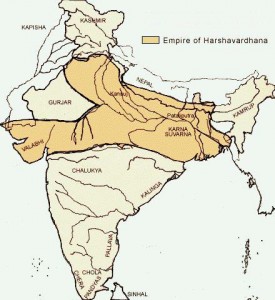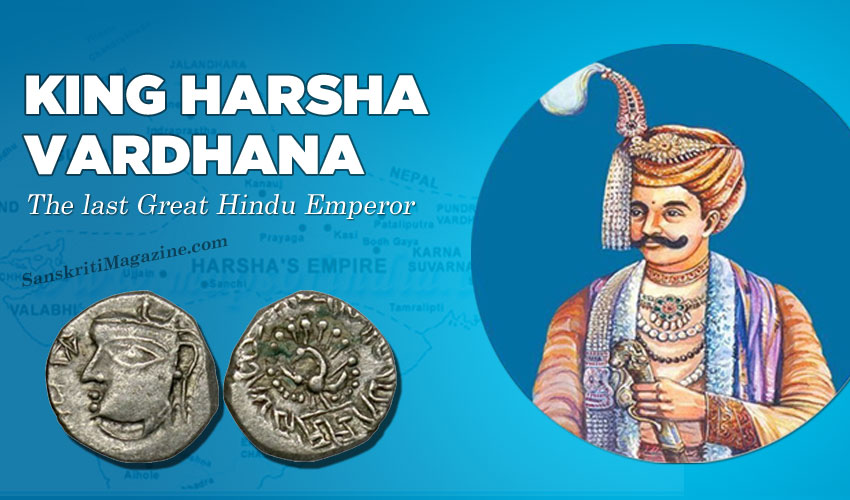One of North India’s most celebrated heroes, Harsha (ca. 590-647) was a gifted warrior-administrator, a sensitive poet and playwright, and a generous patron of religions and the arts.
From the middle of the 5th century North India was subjected to the incursions of marauding Huns. Their activity hastened the decline of the Gupta Empire, which dissolved by the mid-6th century, leaving North India again fractured politically into several independent sovereignties. Two dominant among these were the Maukhari, who ruled the region around the city of Kanyakubja (Kanauj), and the Pushyabhuti, who controlled lands north of Kanauj from their capital at Sthanvisvara (Thaneswar).
 Harsha was the younger of two sons of the Pushyabhuti ruler Prabhakaravardhana. In 604 Prabhakara ordered his older son, Rajyavardhana, to march against the still-active Huns. During that campaign Prabhakara died. Shortly thereafter the young princes learned that their sister’s husband, Grahavarman – the Maukhari ruler of Kanauj – had been killed and that she had been imprisoned by forces from the east under the joint leadership of the Malava Gupta king and the Bengali prince Sasanka. Rajyavardhana marched south and defeated the Malava but was slain – treacherously, according to Bana – by the Bengali. Harsha dispatched an army to meet the Bengali’s forces while he went himself in search of his widowed sister. Bana’s story concludes with Harsha’s rescuing his sister from a funeral pyre and rejoining his army. There is no record of a military encounter between his troops and Sasanka’s.
Harsha was the younger of two sons of the Pushyabhuti ruler Prabhakaravardhana. In 604 Prabhakara ordered his older son, Rajyavardhana, to march against the still-active Huns. During that campaign Prabhakara died. Shortly thereafter the young princes learned that their sister’s husband, Grahavarman – the Maukhari ruler of Kanauj – had been killed and that she had been imprisoned by forces from the east under the joint leadership of the Malava Gupta king and the Bengali prince Sasanka. Rajyavardhana marched south and defeated the Malava but was slain – treacherously, according to Bana – by the Bengali. Harsha dispatched an army to meet the Bengali’s forces while he went himself in search of his widowed sister. Bana’s story concludes with Harsha’s rescuing his sister from a funeral pyre and rejoining his army. There is no record of a military encounter between his troops and Sasanka’s.
In addition to ruling traditional Pushyabhuti lands, Harsha accepted regency of the Maukhari territory and soon made Kanauj his major city. As regent, he took the title Kumara (Prince) Siladitya (Sun in Virtues).
Warrior and Administrator
The first 6 years of the young king’s reign were years of almost ceaseless military campaigning. It is held that during this period Harsha brought much of North India under his control – from Gujarat and the Punjab in the west to Assam (but presumably not Bengal) in the east.
Tradition has it that Harsha suffered his only military defeat in a battle against the Chalukya king Pulakesin II, but since some historians date the battle in 612 and others in 620, it is possible that the testimony refers not to a single great military setback but rather to Harsha’s inability to extend his political authority into the Deccan.
With the exception of the Thaneswar and Kanauj territories which were under Harsha’s immediate control, the lands in his empire were administered by feudatories, who were often the traditional rulers recommissioned as viceroys. Harsha does not seem to have devised any new administrative policies or techniques, nor does it appear that the network of political and economic control was as secure as that of the Mauryas or the imperial Guptas before him. What could not be provided through a system Harsha attempted to give personally. It is said that he spent far the greater part of his time traveling from one district to another, holding court and giving audience.
Patron and Artist
Harsha was a distinguished and creative patron of religions and the arts. He lavished gifts on Buddhist institutions, and it is clear that he was profoundly influenced by Buddhist thought and practices. Still, there is no evidence that he became a Buddhist; rather it would seem that he remained adevotee of Shiva. Late in his life he may have become more concerned with the prosperity of Buddhist institutions as he emulated the manner of Asoka Maurya.
Kings and princes of India prided themselves on the accomplishments of artists, scholars, and poets whom they attracted to their courts. Harsha was no exception. And he had reason to be proud, for in his court were such great literary personalities as Banabhatta and Mayura.
Harsha’s participation in the cultured life of his court was more direct than that of most kings, and it is in his personal contribution to Sanskrit literature that he clearly overshadows them. To him are assigned three plays: Priyadarsika, Ratnavali, and the Nagananda. In addition, he is credited with two significant poems on Buddhist themes – the Ashtamahasricaityastotra (Praise to Eight Grand Caityas [Buddhist assembly halls]) and Suprabhatastotra (Laud to Morning) – and a tract on grammatical gender, the Linganusasanam. Harsha’s authorship has been disputed on several occasions, but no decisive contrary arguments have been proposed.
The Priyadarsika appears to be the earliest of Harsha’s plays. It and the Ratnavali deal with the amorous adventures of the king Vatsa, his queen Vasavadatta, and newcomers to the royal harem. Both plays borrow from the earlier works of Bhasa and Kalidasa (especially the latter’s Malavikagnimitra) and are based ultimately on material in the collection Brhatkatha. These plays lack thematic novelty but sustain interest through brisk dialogue. Both are frequently cited by later writers on dramatic theory and technique.
Harsha’s Nagananda is his most important play. It is, in fact, a singular creation in Sanskrit drama. This five-act drama draws again on the Brhatkatha for the substance of its first three acts. In them, the hero, Jimutavahana, Prince of the Vidyadharas, meets and marries the Siddha princess Malayavati. To that point, the romance of the fairy prince and princess is quite conventional.
The mood of the play changes sharply in the fourth act. Jimutavahana discovers mounds of skeletons which evidence the daily sacrifice of serpents to the celestial bird Garuda. The hero resolves to offer his own body so that the serpents may be spared (a type of resolution very familiar in Buddhist literature). At the drama’s conclusion it is the non-Buddhist goddess Gauri, however, who restores the bodhisattva, Jimutavahana, to life. In this attractive and moving drama, Harsha combined Buddhist and “Hindu” themes adroitly and uniquely, and through it one sees clearly his artistic and political genius.
With Harsha’s death passed an age unduplicated in Indian history. There would be other Hindu political structures more extensive and longer-lived than Harsha’s; and there would appear Sanskrit authors more facile and ingenious than he. But India has not produced again an individual of such wide-ranging talents who could wield the sword, the scepter, and the pen with equal authority.
Further Reading
Harsha’s most important literary works – his three plays – are available in a single, convenient volume with Sanskrit text and English translation:
- Sri Harsa’s Plays, translated by Bak Kun Bae (1964).
- The major biographical study of Harsha is still Radha Kumud Mookerji, Harsha (1926).
- Additional important material is in Rama Shankar Tripathi, History of Kanauj to the Moslem Conquest (1937).
- A recent popular biography is V. D. Gangal, Harsha (1968). D. Devahuti, Harsha: A Political Study (1971), concentrates on the imperial system Harsha developed.











